ECON20039: Microeconomics and Sustainability Essay, Term 3, 2019
VerifiedAdded on 2022/09/01
|17
|3878
|17
Essay
AI Summary
This essay delves into the core concepts of microeconomics and sustainability, addressing key economic principles. It begins by defining and analyzing price elasticity of demand, differentiating between elastic and inelastic demands, and illustrating these concepts with examples from the car and gold markets. The essay then explores oligopoly market structures, defining their characteristics and examining the car manufacturing industry as an example, including discussions on product differentiation and advertising. Finally, the essay investigates climate change, its causes and economic consequences, specifically within the context of Australia, and evaluates government measures aimed at environmental protection. The analysis incorporates economic journals, providing a well-researched overview of these interconnected topics.
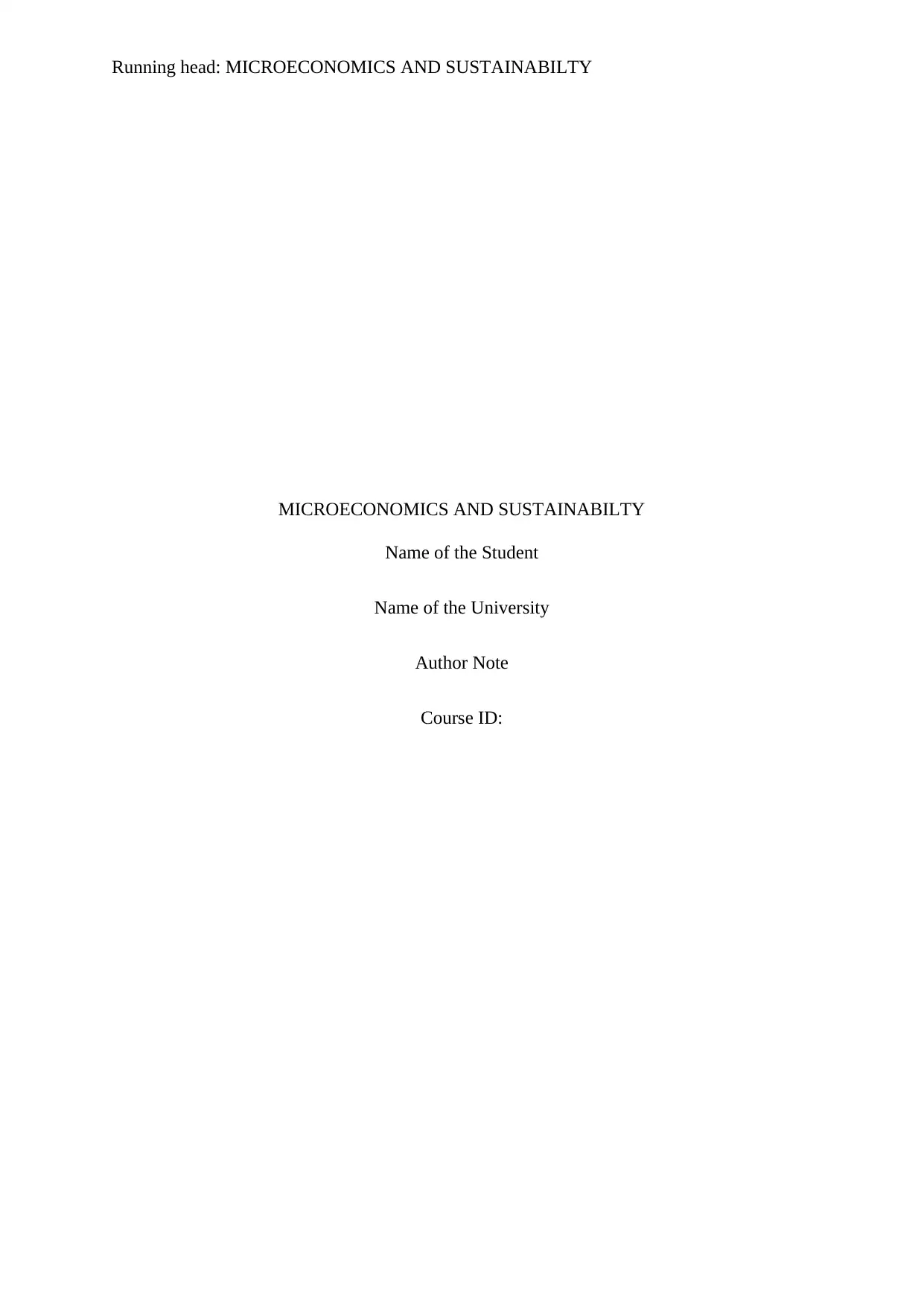
Running head: MICROECONOMICS AND SUSTAINABILTY
MICROECONOMICS AND SUSTAINABILTY
Name of the Student
Name of the University
Author Note
Course ID:
MICROECONOMICS AND SUSTAINABILTY
Name of the Student
Name of the University
Author Note
Course ID:
Paraphrase This Document
Need a fresh take? Get an instant paraphrase of this document with our AI Paraphraser
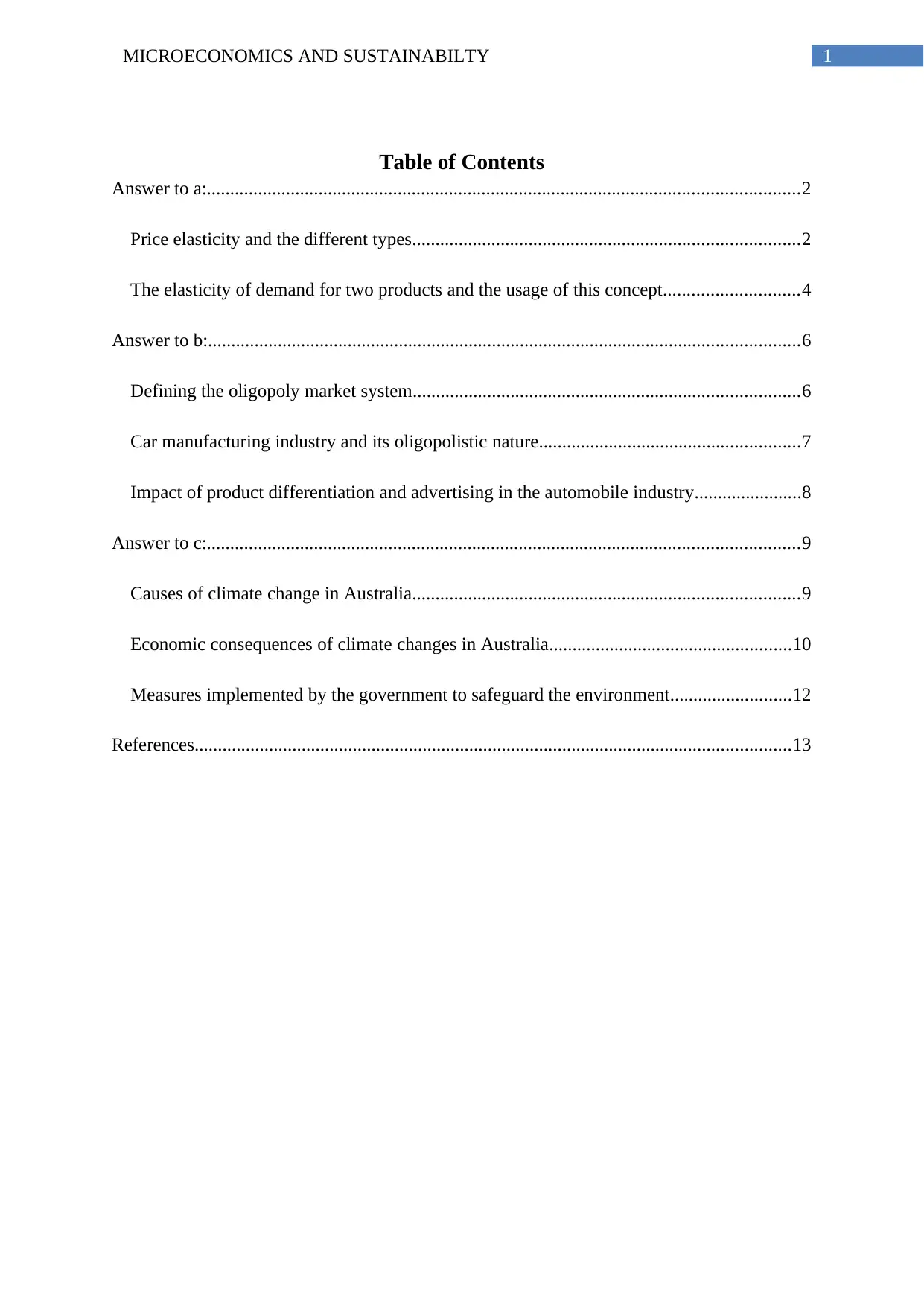
1MICROECONOMICS AND SUSTAINABILTY
Table of Contents
Answer to a:...............................................................................................................................2
Price elasticity and the different types...................................................................................2
The elasticity of demand for two products and the usage of this concept.............................4
Answer to b:...............................................................................................................................6
Defining the oligopoly market system...................................................................................6
Car manufacturing industry and its oligopolistic nature........................................................7
Impact of product differentiation and advertising in the automobile industry.......................8
Answer to c:...............................................................................................................................9
Causes of climate change in Australia...................................................................................9
Economic consequences of climate changes in Australia....................................................10
Measures implemented by the government to safeguard the environment..........................12
References................................................................................................................................13
Table of Contents
Answer to a:...............................................................................................................................2
Price elasticity and the different types...................................................................................2
The elasticity of demand for two products and the usage of this concept.............................4
Answer to b:...............................................................................................................................6
Defining the oligopoly market system...................................................................................6
Car manufacturing industry and its oligopolistic nature........................................................7
Impact of product differentiation and advertising in the automobile industry.......................8
Answer to c:...............................................................................................................................9
Causes of climate change in Australia...................................................................................9
Economic consequences of climate changes in Australia....................................................10
Measures implemented by the government to safeguard the environment..........................12
References................................................................................................................................13
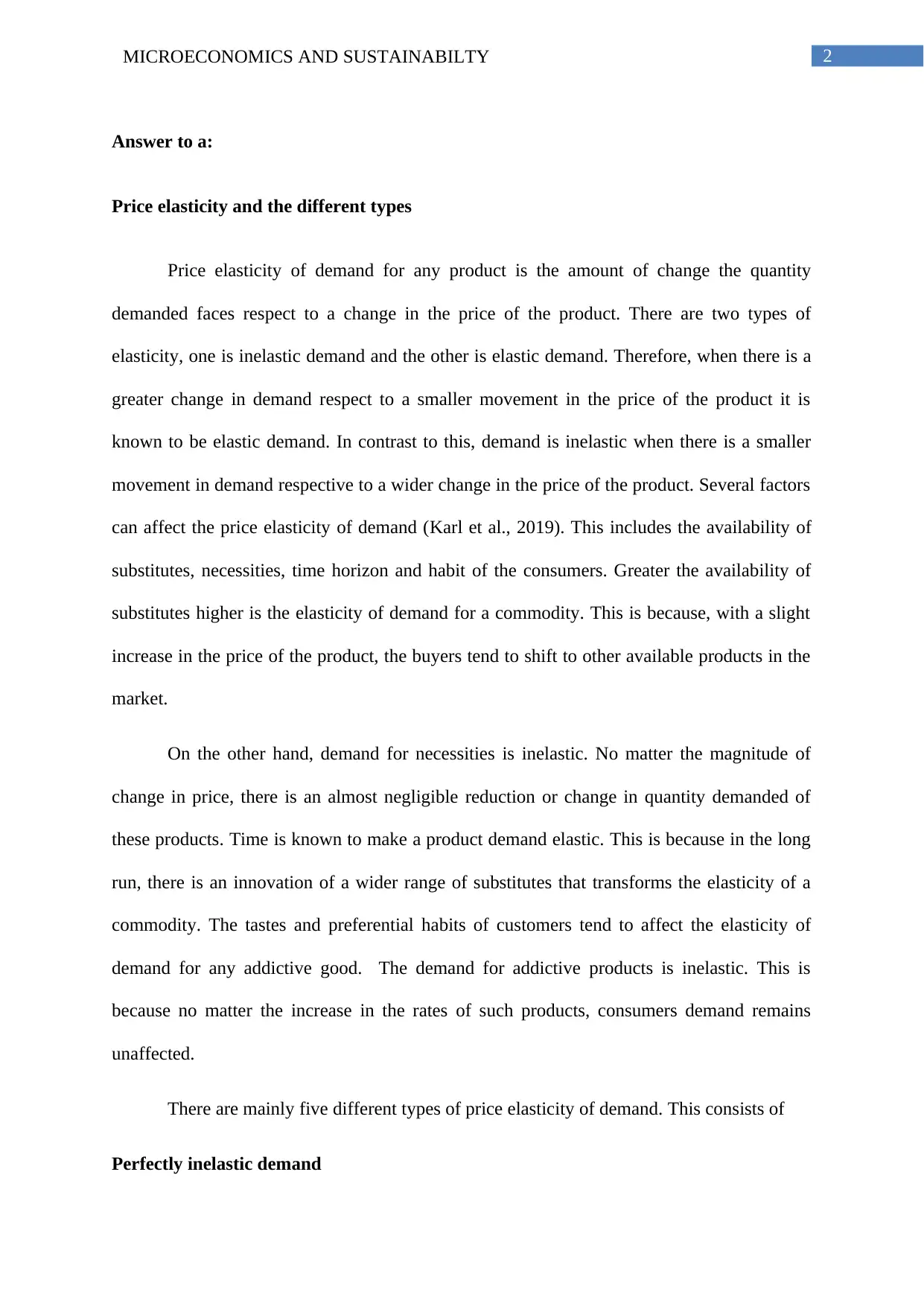
2MICROECONOMICS AND SUSTAINABILTY
Answer to a:
Price elasticity and the different types
Price elasticity of demand for any product is the amount of change the quantity
demanded faces respect to a change in the price of the product. There are two types of
elasticity, one is inelastic demand and the other is elastic demand. Therefore, when there is a
greater change in demand respect to a smaller movement in the price of the product it is
known to be elastic demand. In contrast to this, demand is inelastic when there is a smaller
movement in demand respective to a wider change in the price of the product. Several factors
can affect the price elasticity of demand (Karl et al., 2019). This includes the availability of
substitutes, necessities, time horizon and habit of the consumers. Greater the availability of
substitutes higher is the elasticity of demand for a commodity. This is because, with a slight
increase in the price of the product, the buyers tend to shift to other available products in the
market.
On the other hand, demand for necessities is inelastic. No matter the magnitude of
change in price, there is an almost negligible reduction or change in quantity demanded of
these products. Time is known to make a product demand elastic. This is because in the long
run, there is an innovation of a wider range of substitutes that transforms the elasticity of a
commodity. The tastes and preferential habits of customers tend to affect the elasticity of
demand for any addictive good. The demand for addictive products is inelastic. This is
because no matter the increase in the rates of such products, consumers demand remains
unaffected.
There are mainly five different types of price elasticity of demand. This consists of
Perfectly inelastic demand
Answer to a:
Price elasticity and the different types
Price elasticity of demand for any product is the amount of change the quantity
demanded faces respect to a change in the price of the product. There are two types of
elasticity, one is inelastic demand and the other is elastic demand. Therefore, when there is a
greater change in demand respect to a smaller movement in the price of the product it is
known to be elastic demand. In contrast to this, demand is inelastic when there is a smaller
movement in demand respective to a wider change in the price of the product. Several factors
can affect the price elasticity of demand (Karl et al., 2019). This includes the availability of
substitutes, necessities, time horizon and habit of the consumers. Greater the availability of
substitutes higher is the elasticity of demand for a commodity. This is because, with a slight
increase in the price of the product, the buyers tend to shift to other available products in the
market.
On the other hand, demand for necessities is inelastic. No matter the magnitude of
change in price, there is an almost negligible reduction or change in quantity demanded of
these products. Time is known to make a product demand elastic. This is because in the long
run, there is an innovation of a wider range of substitutes that transforms the elasticity of a
commodity. The tastes and preferential habits of customers tend to affect the elasticity of
demand for any addictive good. The demand for addictive products is inelastic. This is
because no matter the increase in the rates of such products, consumers demand remains
unaffected.
There are mainly five different types of price elasticity of demand. This consists of
Perfectly inelastic demand
⊘ This is a preview!⊘
Do you want full access?
Subscribe today to unlock all pages.

Trusted by 1+ million students worldwide
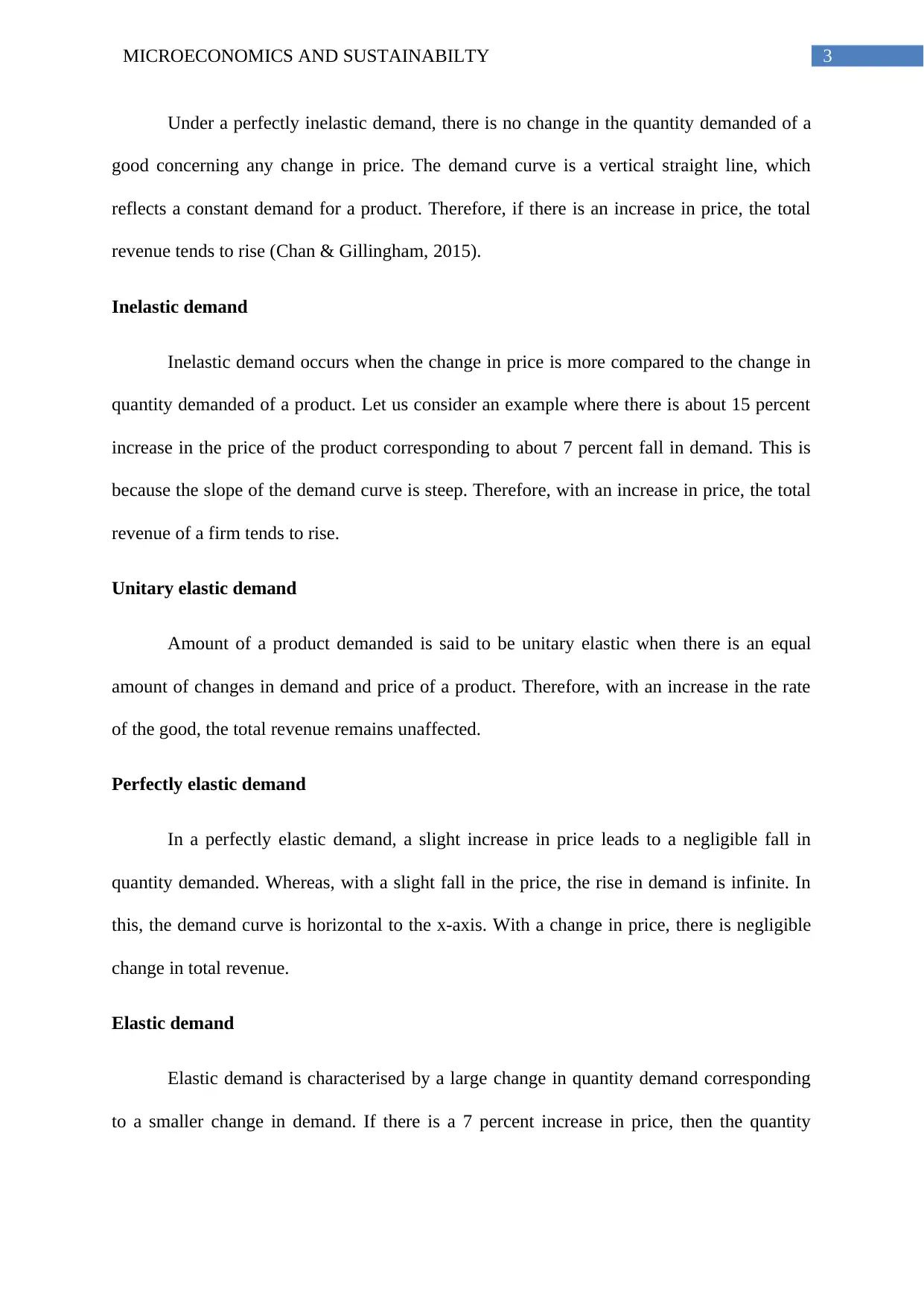
3MICROECONOMICS AND SUSTAINABILTY
Under a perfectly inelastic demand, there is no change in the quantity demanded of a
good concerning any change in price. The demand curve is a vertical straight line, which
reflects a constant demand for a product. Therefore, if there is an increase in price, the total
revenue tends to rise (Chan & Gillingham, 2015).
Inelastic demand
Inelastic demand occurs when the change in price is more compared to the change in
quantity demanded of a product. Let us consider an example where there is about 15 percent
increase in the price of the product corresponding to about 7 percent fall in demand. This is
because the slope of the demand curve is steep. Therefore, with an increase in price, the total
revenue of a firm tends to rise.
Unitary elastic demand
Amount of a product demanded is said to be unitary elastic when there is an equal
amount of changes in demand and price of a product. Therefore, with an increase in the rate
of the good, the total revenue remains unaffected.
Perfectly elastic demand
In a perfectly elastic demand, a slight increase in price leads to a negligible fall in
quantity demanded. Whereas, with a slight fall in the price, the rise in demand is infinite. In
this, the demand curve is horizontal to the x-axis. With a change in price, there is negligible
change in total revenue.
Elastic demand
Elastic demand is characterised by a large change in quantity demand corresponding
to a smaller change in demand. If there is a 7 percent increase in price, then the quantity
Under a perfectly inelastic demand, there is no change in the quantity demanded of a
good concerning any change in price. The demand curve is a vertical straight line, which
reflects a constant demand for a product. Therefore, if there is an increase in price, the total
revenue tends to rise (Chan & Gillingham, 2015).
Inelastic demand
Inelastic demand occurs when the change in price is more compared to the change in
quantity demanded of a product. Let us consider an example where there is about 15 percent
increase in the price of the product corresponding to about 7 percent fall in demand. This is
because the slope of the demand curve is steep. Therefore, with an increase in price, the total
revenue of a firm tends to rise.
Unitary elastic demand
Amount of a product demanded is said to be unitary elastic when there is an equal
amount of changes in demand and price of a product. Therefore, with an increase in the rate
of the good, the total revenue remains unaffected.
Perfectly elastic demand
In a perfectly elastic demand, a slight increase in price leads to a negligible fall in
quantity demanded. Whereas, with a slight fall in the price, the rise in demand is infinite. In
this, the demand curve is horizontal to the x-axis. With a change in price, there is negligible
change in total revenue.
Elastic demand
Elastic demand is characterised by a large change in quantity demand corresponding
to a smaller change in demand. If there is a 7 percent increase in price, then the quantity
Paraphrase This Document
Need a fresh take? Get an instant paraphrase of this document with our AI Paraphraser
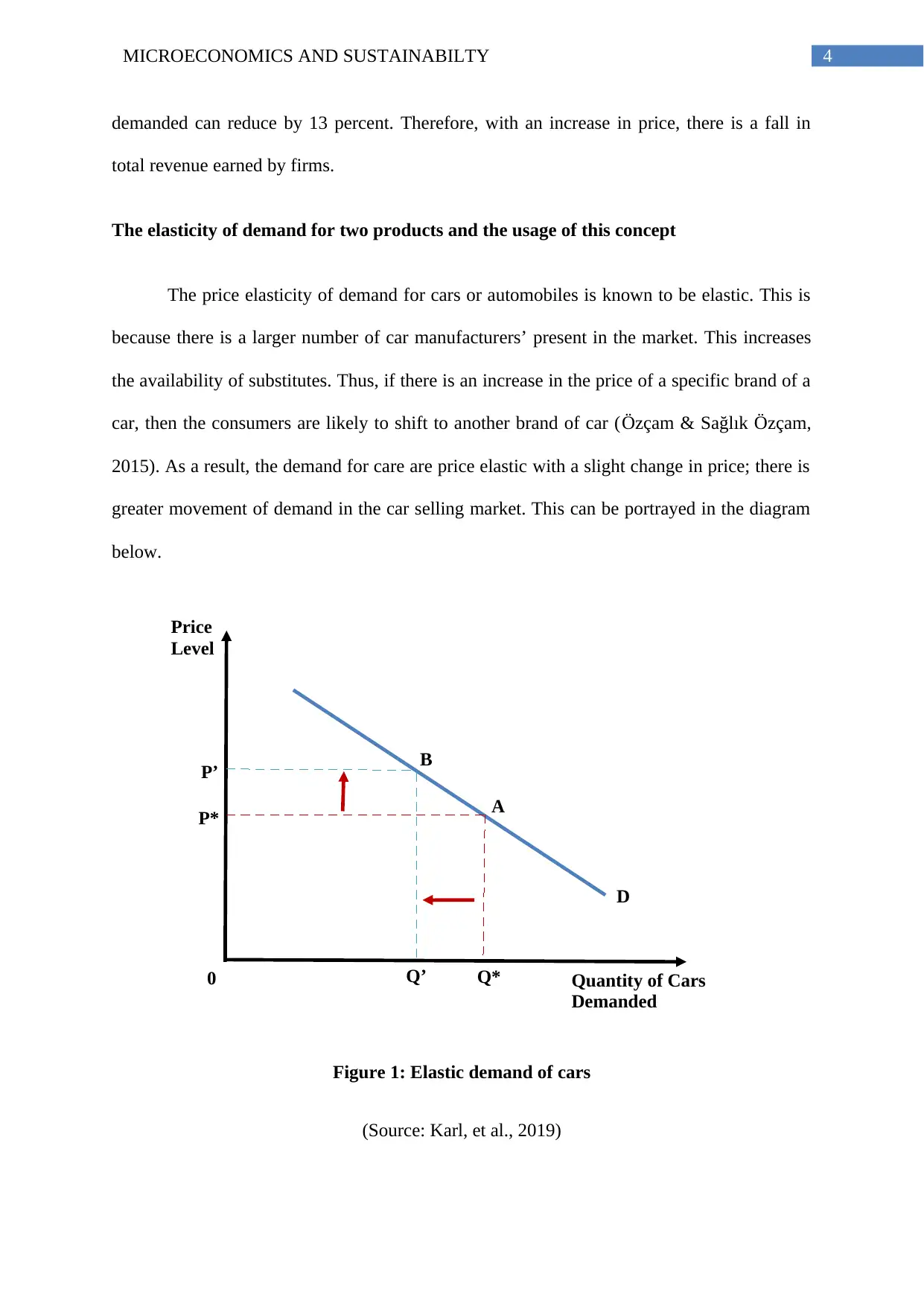
4MICROECONOMICS AND SUSTAINABILTY
D
B
Price
Level
Quantity of Cars
Demanded
0
P*
Q*
A
P’
Q’
demanded can reduce by 13 percent. Therefore, with an increase in price, there is a fall in
total revenue earned by firms.
The elasticity of demand for two products and the usage of this concept
The price elasticity of demand for cars or automobiles is known to be elastic. This is
because there is a larger number of car manufacturers’ present in the market. This increases
the availability of substitutes. Thus, if there is an increase in the price of a specific brand of a
car, then the consumers are likely to shift to another brand of car (Özçam & Sağlık Özçam,
2015). As a result, the demand for care are price elastic with a slight change in price; there is
greater movement of demand in the car selling market. This can be portrayed in the diagram
below.
Figure 1: Elastic demand of cars
(Source: Karl, et al., 2019)
D
B
Price
Level
Quantity of Cars
Demanded
0
P*
Q*
A
P’
Q’
demanded can reduce by 13 percent. Therefore, with an increase in price, there is a fall in
total revenue earned by firms.
The elasticity of demand for two products and the usage of this concept
The price elasticity of demand for cars or automobiles is known to be elastic. This is
because there is a larger number of car manufacturers’ present in the market. This increases
the availability of substitutes. Thus, if there is an increase in the price of a specific brand of a
car, then the consumers are likely to shift to another brand of car (Özçam & Sağlık Özçam,
2015). As a result, the demand for care are price elastic with a slight change in price; there is
greater movement of demand in the car selling market. This can be portrayed in the diagram
below.
Figure 1: Elastic demand of cars
(Source: Karl, et al., 2019)
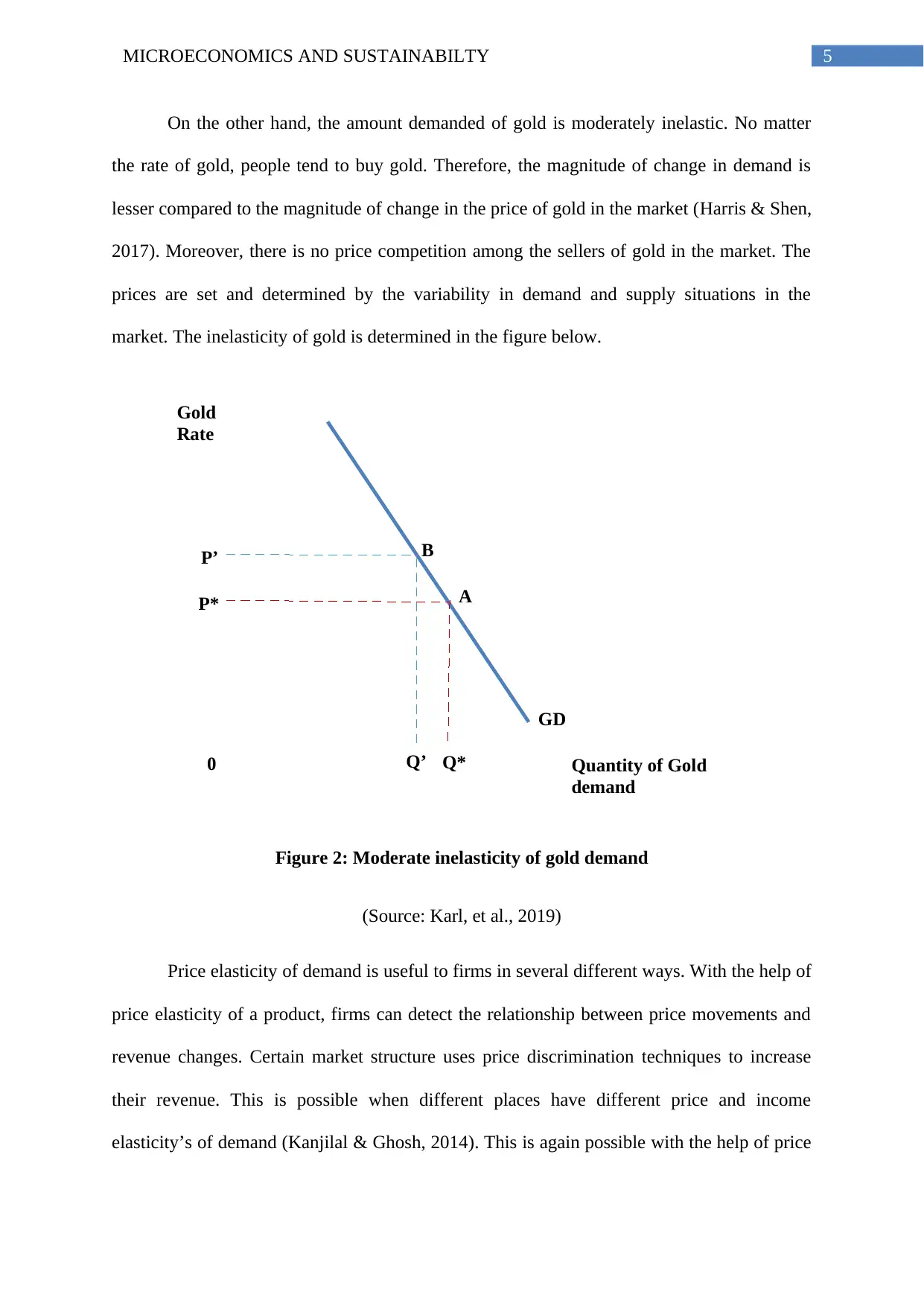
5MICROECONOMICS AND SUSTAINABILTY
GD
B
Gold
Rate
Quantity of Gold
demand
0
P*
Q*
A
P’
Q’
On the other hand, the amount demanded of gold is moderately inelastic. No matter
the rate of gold, people tend to buy gold. Therefore, the magnitude of change in demand is
lesser compared to the magnitude of change in the price of gold in the market (Harris & Shen,
2017). Moreover, there is no price competition among the sellers of gold in the market. The
prices are set and determined by the variability in demand and supply situations in the
market. The inelasticity of gold is determined in the figure below.
Figure 2: Moderate inelasticity of gold demand
(Source: Karl, et al., 2019)
Price elasticity of demand is useful to firms in several different ways. With the help of
price elasticity of a product, firms can detect the relationship between price movements and
revenue changes. Certain market structure uses price discrimination techniques to increase
their revenue. This is possible when different places have different price and income
elasticity’s of demand (Kanjilal & Ghosh, 2014). This is again possible with the help of price
GD
B
Gold
Rate
Quantity of Gold
demand
0
P*
Q*
A
P’
Q’
On the other hand, the amount demanded of gold is moderately inelastic. No matter
the rate of gold, people tend to buy gold. Therefore, the magnitude of change in demand is
lesser compared to the magnitude of change in the price of gold in the market (Harris & Shen,
2017). Moreover, there is no price competition among the sellers of gold in the market. The
prices are set and determined by the variability in demand and supply situations in the
market. The inelasticity of gold is determined in the figure below.
Figure 2: Moderate inelasticity of gold demand
(Source: Karl, et al., 2019)
Price elasticity of demand is useful to firms in several different ways. With the help of
price elasticity of a product, firms can detect the relationship between price movements and
revenue changes. Certain market structure uses price discrimination techniques to increase
their revenue. This is possible when different places have different price and income
elasticity’s of demand (Kanjilal & Ghosh, 2014). This is again possible with the help of price
⊘ This is a preview!⊘
Do you want full access?
Subscribe today to unlock all pages.

Trusted by 1+ million students worldwide
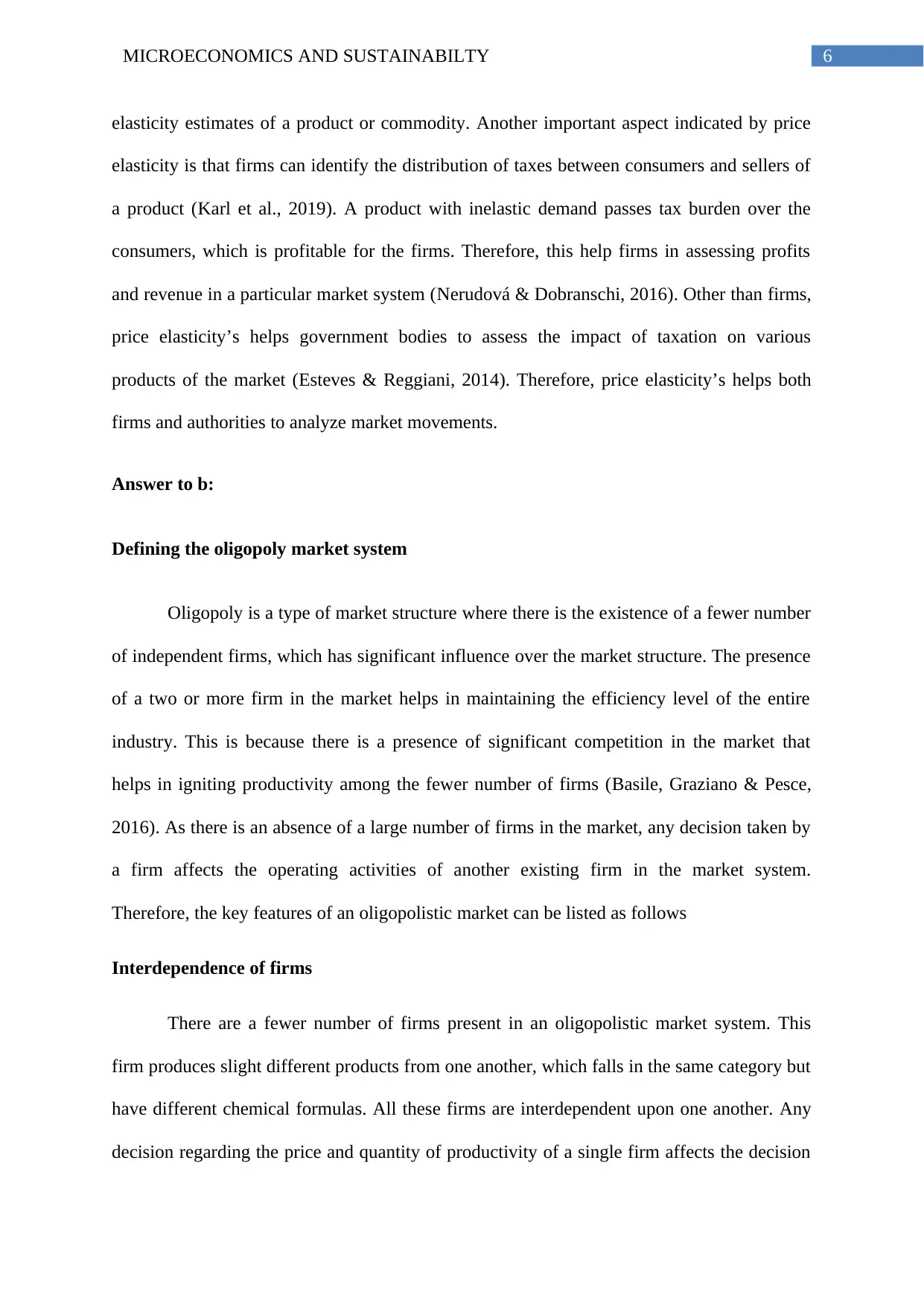
6MICROECONOMICS AND SUSTAINABILTY
elasticity estimates of a product or commodity. Another important aspect indicated by price
elasticity is that firms can identify the distribution of taxes between consumers and sellers of
a product (Karl et al., 2019). A product with inelastic demand passes tax burden over the
consumers, which is profitable for the firms. Therefore, this help firms in assessing profits
and revenue in a particular market system (Nerudová & Dobranschi, 2016). Other than firms,
price elasticity’s helps government bodies to assess the impact of taxation on various
products of the market (Esteves & Reggiani, 2014). Therefore, price elasticity’s helps both
firms and authorities to analyze market movements.
Answer to b:
Defining the oligopoly market system
Oligopoly is a type of market structure where there is the existence of a fewer number
of independent firms, which has significant influence over the market structure. The presence
of a two or more firm in the market helps in maintaining the efficiency level of the entire
industry. This is because there is a presence of significant competition in the market that
helps in igniting productivity among the fewer number of firms (Basile, Graziano & Pesce,
2016). As there is an absence of a large number of firms in the market, any decision taken by
a firm affects the operating activities of another existing firm in the market system.
Therefore, the key features of an oligopolistic market can be listed as follows
Interdependence of firms
There are a fewer number of firms present in an oligopolistic market system. This
firm produces slight different products from one another, which falls in the same category but
have different chemical formulas. All these firms are interdependent upon one another. Any
decision regarding the price and quantity of productivity of a single firm affects the decision
elasticity estimates of a product or commodity. Another important aspect indicated by price
elasticity is that firms can identify the distribution of taxes between consumers and sellers of
a product (Karl et al., 2019). A product with inelastic demand passes tax burden over the
consumers, which is profitable for the firms. Therefore, this help firms in assessing profits
and revenue in a particular market system (Nerudová & Dobranschi, 2016). Other than firms,
price elasticity’s helps government bodies to assess the impact of taxation on various
products of the market (Esteves & Reggiani, 2014). Therefore, price elasticity’s helps both
firms and authorities to analyze market movements.
Answer to b:
Defining the oligopoly market system
Oligopoly is a type of market structure where there is the existence of a fewer number
of independent firms, which has significant influence over the market structure. The presence
of a two or more firm in the market helps in maintaining the efficiency level of the entire
industry. This is because there is a presence of significant competition in the market that
helps in igniting productivity among the fewer number of firms (Basile, Graziano & Pesce,
2016). As there is an absence of a large number of firms in the market, any decision taken by
a firm affects the operating activities of another existing firm in the market system.
Therefore, the key features of an oligopolistic market can be listed as follows
Interdependence of firms
There are a fewer number of firms present in an oligopolistic market system. This
firm produces slight different products from one another, which falls in the same category but
have different chemical formulas. All these firms are interdependent upon one another. Any
decision regarding the price and quantity of productivity of a single firm affects the decision
Paraphrase This Document
Need a fresh take? Get an instant paraphrase of this document with our AI Paraphraser
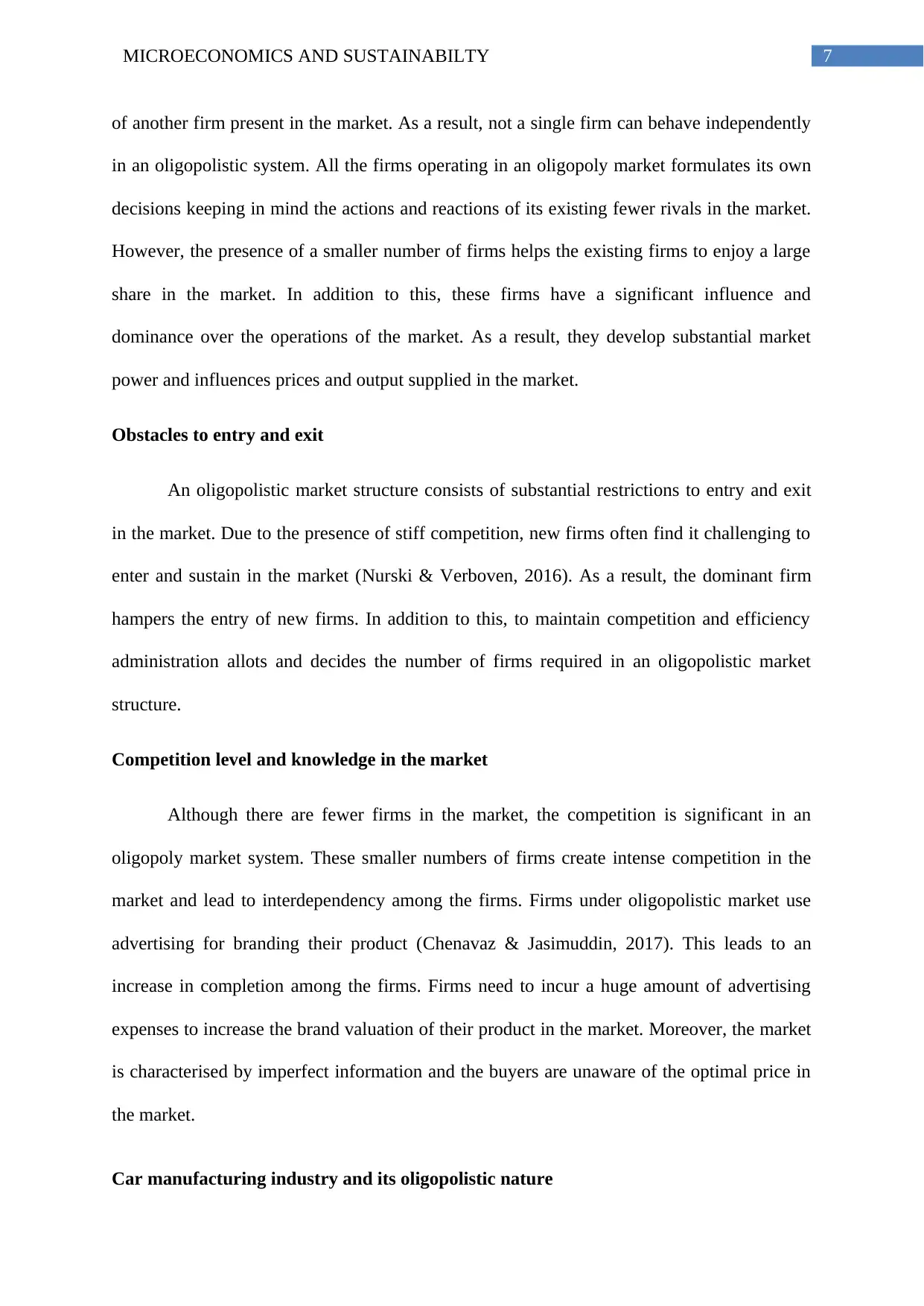
7MICROECONOMICS AND SUSTAINABILTY
of another firm present in the market. As a result, not a single firm can behave independently
in an oligopolistic system. All the firms operating in an oligopoly market formulates its own
decisions keeping in mind the actions and reactions of its existing fewer rivals in the market.
However, the presence of a smaller number of firms helps the existing firms to enjoy a large
share in the market. In addition to this, these firms have a significant influence and
dominance over the operations of the market. As a result, they develop substantial market
power and influences prices and output supplied in the market.
Obstacles to entry and exit
An oligopolistic market structure consists of substantial restrictions to entry and exit
in the market. Due to the presence of stiff competition, new firms often find it challenging to
enter and sustain in the market (Nurski & Verboven, 2016). As a result, the dominant firm
hampers the entry of new firms. In addition to this, to maintain competition and efficiency
administration allots and decides the number of firms required in an oligopolistic market
structure.
Competition level and knowledge in the market
Although there are fewer firms in the market, the competition is significant in an
oligopoly market system. These smaller numbers of firms create intense competition in the
market and lead to interdependency among the firms. Firms under oligopolistic market use
advertising for branding their product (Chenavaz & Jasimuddin, 2017). This leads to an
increase in completion among the firms. Firms need to incur a huge amount of advertising
expenses to increase the brand valuation of their product in the market. Moreover, the market
is characterised by imperfect information and the buyers are unaware of the optimal price in
the market.
Car manufacturing industry and its oligopolistic nature
of another firm present in the market. As a result, not a single firm can behave independently
in an oligopolistic system. All the firms operating in an oligopoly market formulates its own
decisions keeping in mind the actions and reactions of its existing fewer rivals in the market.
However, the presence of a smaller number of firms helps the existing firms to enjoy a large
share in the market. In addition to this, these firms have a significant influence and
dominance over the operations of the market. As a result, they develop substantial market
power and influences prices and output supplied in the market.
Obstacles to entry and exit
An oligopolistic market structure consists of substantial restrictions to entry and exit
in the market. Due to the presence of stiff competition, new firms often find it challenging to
enter and sustain in the market (Nurski & Verboven, 2016). As a result, the dominant firm
hampers the entry of new firms. In addition to this, to maintain competition and efficiency
administration allots and decides the number of firms required in an oligopolistic market
structure.
Competition level and knowledge in the market
Although there are fewer firms in the market, the competition is significant in an
oligopoly market system. These smaller numbers of firms create intense competition in the
market and lead to interdependency among the firms. Firms under oligopolistic market use
advertising for branding their product (Chenavaz & Jasimuddin, 2017). This leads to an
increase in completion among the firms. Firms need to incur a huge amount of advertising
expenses to increase the brand valuation of their product in the market. Moreover, the market
is characterised by imperfect information and the buyers are unaware of the optimal price in
the market.
Car manufacturing industry and its oligopolistic nature
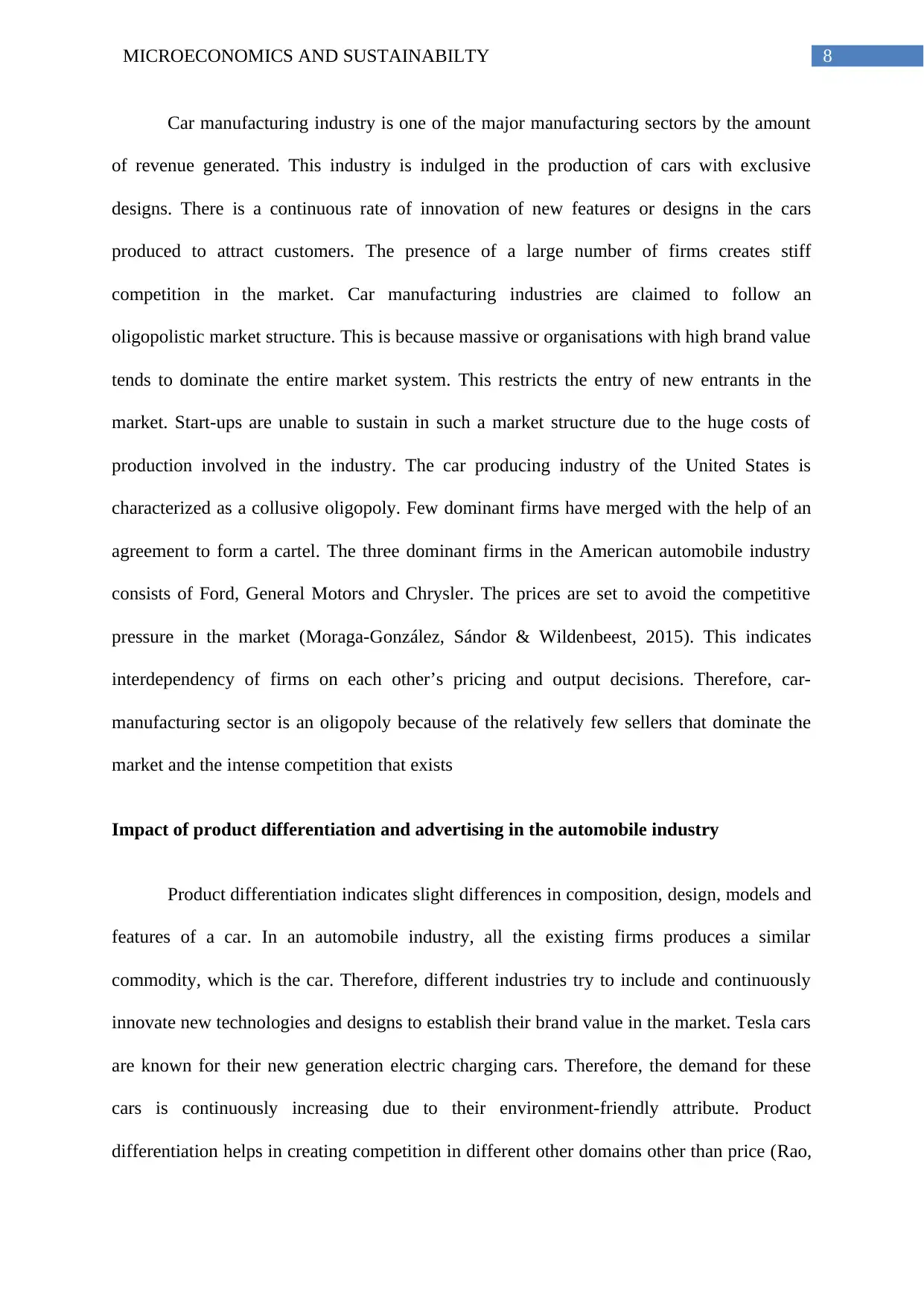
8MICROECONOMICS AND SUSTAINABILTY
Car manufacturing industry is one of the major manufacturing sectors by the amount
of revenue generated. This industry is indulged in the production of cars with exclusive
designs. There is a continuous rate of innovation of new features or designs in the cars
produced to attract customers. The presence of a large number of firms creates stiff
competition in the market. Car manufacturing industries are claimed to follow an
oligopolistic market structure. This is because massive or organisations with high brand value
tends to dominate the entire market system. This restricts the entry of new entrants in the
market. Start-ups are unable to sustain in such a market structure due to the huge costs of
production involved in the industry. The car producing industry of the United States is
characterized as a collusive oligopoly. Few dominant firms have merged with the help of an
agreement to form a cartel. The three dominant firms in the American automobile industry
consists of Ford, General Motors and Chrysler. The prices are set to avoid the competitive
pressure in the market (Moraga-González, Sándor & Wildenbeest, 2015). This indicates
interdependency of firms on each other’s pricing and output decisions. Therefore, car-
manufacturing sector is an oligopoly because of the relatively few sellers that dominate the
market and the intense competition that exists
Impact of product differentiation and advertising in the automobile industry
Product differentiation indicates slight differences in composition, design, models and
features of a car. In an automobile industry, all the existing firms produces a similar
commodity, which is the car. Therefore, different industries try to include and continuously
innovate new technologies and designs to establish their brand value in the market. Tesla cars
are known for their new generation electric charging cars. Therefore, the demand for these
cars is continuously increasing due to their environment-friendly attribute. Product
differentiation helps in creating competition in different other domains other than price (Rao,
Car manufacturing industry is one of the major manufacturing sectors by the amount
of revenue generated. This industry is indulged in the production of cars with exclusive
designs. There is a continuous rate of innovation of new features or designs in the cars
produced to attract customers. The presence of a large number of firms creates stiff
competition in the market. Car manufacturing industries are claimed to follow an
oligopolistic market structure. This is because massive or organisations with high brand value
tends to dominate the entire market system. This restricts the entry of new entrants in the
market. Start-ups are unable to sustain in such a market structure due to the huge costs of
production involved in the industry. The car producing industry of the United States is
characterized as a collusive oligopoly. Few dominant firms have merged with the help of an
agreement to form a cartel. The three dominant firms in the American automobile industry
consists of Ford, General Motors and Chrysler. The prices are set to avoid the competitive
pressure in the market (Moraga-González, Sándor & Wildenbeest, 2015). This indicates
interdependency of firms on each other’s pricing and output decisions. Therefore, car-
manufacturing sector is an oligopoly because of the relatively few sellers that dominate the
market and the intense competition that exists
Impact of product differentiation and advertising in the automobile industry
Product differentiation indicates slight differences in composition, design, models and
features of a car. In an automobile industry, all the existing firms produces a similar
commodity, which is the car. Therefore, different industries try to include and continuously
innovate new technologies and designs to establish their brand value in the market. Tesla cars
are known for their new generation electric charging cars. Therefore, the demand for these
cars is continuously increasing due to their environment-friendly attribute. Product
differentiation helps in creating competition in different other domains other than price (Rao,
⊘ This is a preview!⊘
Do you want full access?
Subscribe today to unlock all pages.

Trusted by 1+ million students worldwide
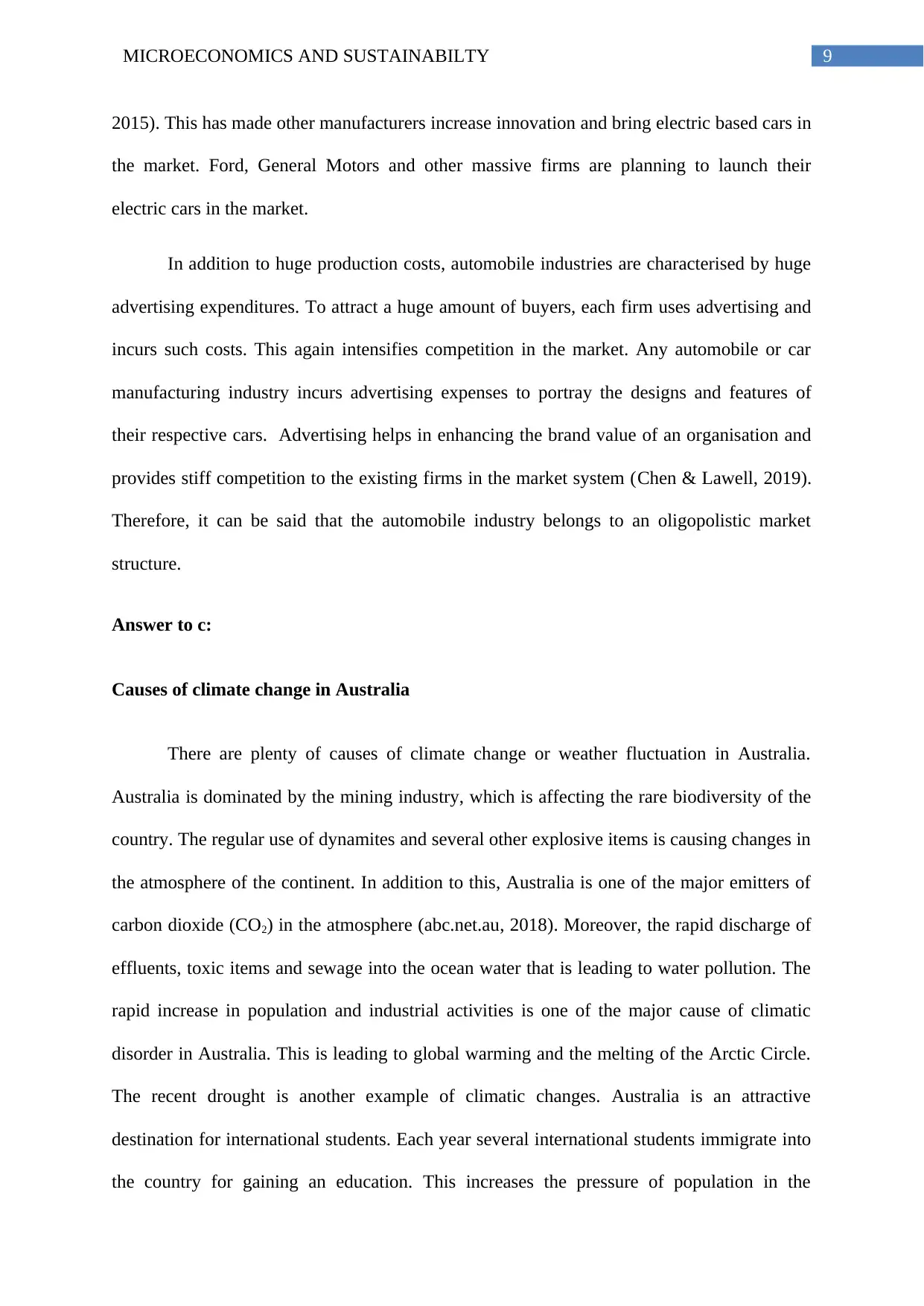
9MICROECONOMICS AND SUSTAINABILTY
2015). This has made other manufacturers increase innovation and bring electric based cars in
the market. Ford, General Motors and other massive firms are planning to launch their
electric cars in the market.
In addition to huge production costs, automobile industries are characterised by huge
advertising expenditures. To attract a huge amount of buyers, each firm uses advertising and
incurs such costs. This again intensifies competition in the market. Any automobile or car
manufacturing industry incurs advertising expenses to portray the designs and features of
their respective cars. Advertising helps in enhancing the brand value of an organisation and
provides stiff competition to the existing firms in the market system (Chen & Lawell, 2019).
Therefore, it can be said that the automobile industry belongs to an oligopolistic market
structure.
Answer to c:
Causes of climate change in Australia
There are plenty of causes of climate change or weather fluctuation in Australia.
Australia is dominated by the mining industry, which is affecting the rare biodiversity of the
country. The regular use of dynamites and several other explosive items is causing changes in
the atmosphere of the continent. In addition to this, Australia is one of the major emitters of
carbon dioxide (CO2) in the atmosphere (abc.net.au, 2018). Moreover, the rapid discharge of
effluents, toxic items and sewage into the ocean water that is leading to water pollution. The
rapid increase in population and industrial activities is one of the major cause of climatic
disorder in Australia. This is leading to global warming and the melting of the Arctic Circle.
The recent drought is another example of climatic changes. Australia is an attractive
destination for international students. Each year several international students immigrate into
the country for gaining an education. This increases the pressure of population in the
2015). This has made other manufacturers increase innovation and bring electric based cars in
the market. Ford, General Motors and other massive firms are planning to launch their
electric cars in the market.
In addition to huge production costs, automobile industries are characterised by huge
advertising expenditures. To attract a huge amount of buyers, each firm uses advertising and
incurs such costs. This again intensifies competition in the market. Any automobile or car
manufacturing industry incurs advertising expenses to portray the designs and features of
their respective cars. Advertising helps in enhancing the brand value of an organisation and
provides stiff competition to the existing firms in the market system (Chen & Lawell, 2019).
Therefore, it can be said that the automobile industry belongs to an oligopolistic market
structure.
Answer to c:
Causes of climate change in Australia
There are plenty of causes of climate change or weather fluctuation in Australia.
Australia is dominated by the mining industry, which is affecting the rare biodiversity of the
country. The regular use of dynamites and several other explosive items is causing changes in
the atmosphere of the continent. In addition to this, Australia is one of the major emitters of
carbon dioxide (CO2) in the atmosphere (abc.net.au, 2018). Moreover, the rapid discharge of
effluents, toxic items and sewage into the ocean water that is leading to water pollution. The
rapid increase in population and industrial activities is one of the major cause of climatic
disorder in Australia. This is leading to global warming and the melting of the Arctic Circle.
The recent drought is another example of climatic changes. Australia is an attractive
destination for international students. Each year several international students immigrate into
the country for gaining an education. This increases the pressure of population in the
Paraphrase This Document
Need a fresh take? Get an instant paraphrase of this document with our AI Paraphraser
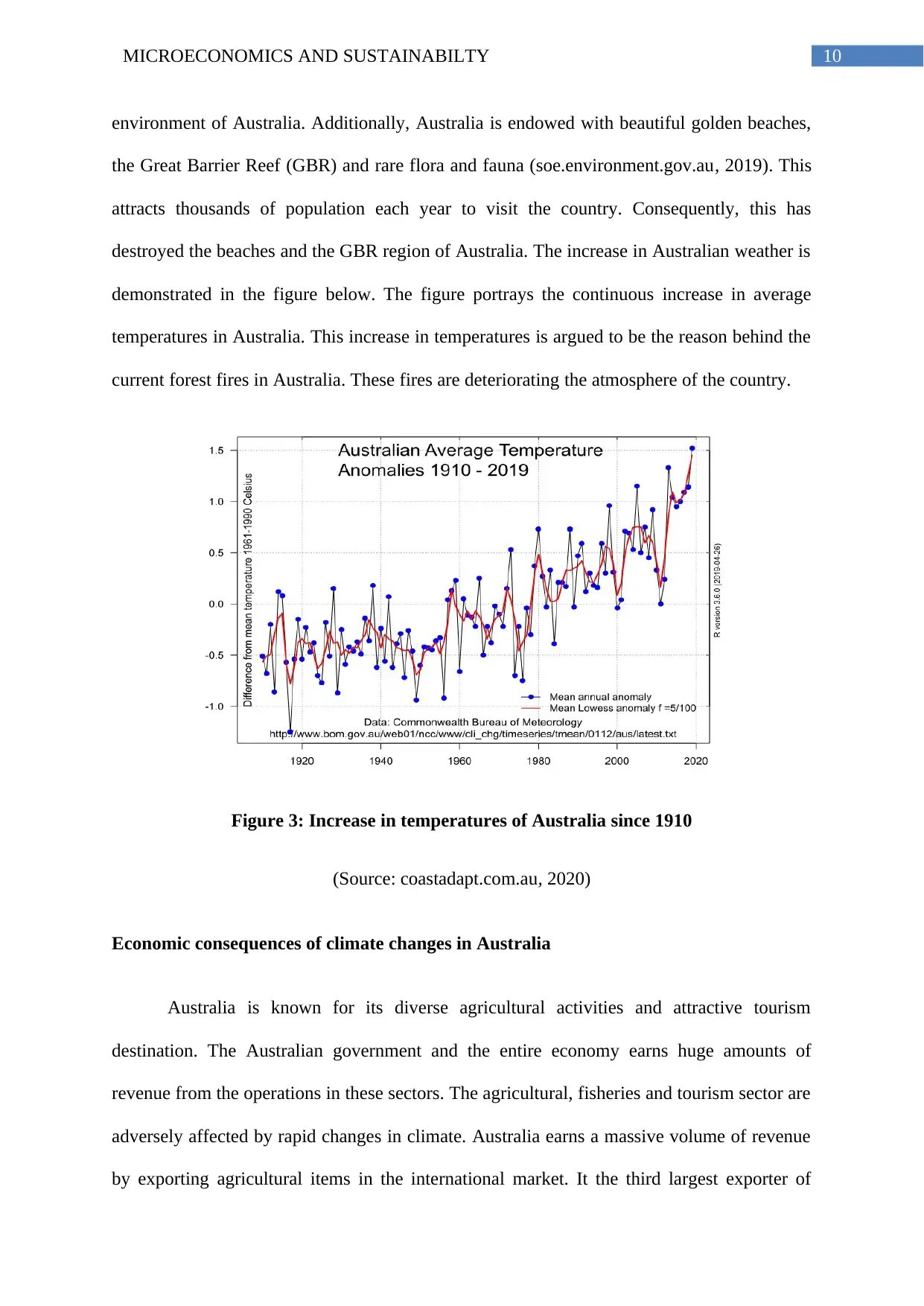
10MICROECONOMICS AND SUSTAINABILTY
environment of Australia. Additionally, Australia is endowed with beautiful golden beaches,
the Great Barrier Reef (GBR) and rare flora and fauna (soe.environment.gov.au, 2019). This
attracts thousands of population each year to visit the country. Consequently, this has
destroyed the beaches and the GBR region of Australia. The increase in Australian weather is
demonstrated in the figure below. The figure portrays the continuous increase in average
temperatures in Australia. This increase in temperatures is argued to be the reason behind the
current forest fires in Australia. These fires are deteriorating the atmosphere of the country.
Figure 3: Increase in temperatures of Australia since 1910
(Source: coastadapt.com.au, 2020)
Economic consequences of climate changes in Australia
Australia is known for its diverse agricultural activities and attractive tourism
destination. The Australian government and the entire economy earns huge amounts of
revenue from the operations in these sectors. The agricultural, fisheries and tourism sector are
adversely affected by rapid changes in climate. Australia earns a massive volume of revenue
by exporting agricultural items in the international market. It the third largest exporter of
environment of Australia. Additionally, Australia is endowed with beautiful golden beaches,
the Great Barrier Reef (GBR) and rare flora and fauna (soe.environment.gov.au, 2019). This
attracts thousands of population each year to visit the country. Consequently, this has
destroyed the beaches and the GBR region of Australia. The increase in Australian weather is
demonstrated in the figure below. The figure portrays the continuous increase in average
temperatures in Australia. This increase in temperatures is argued to be the reason behind the
current forest fires in Australia. These fires are deteriorating the atmosphere of the country.
Figure 3: Increase in temperatures of Australia since 1910
(Source: coastadapt.com.au, 2020)
Economic consequences of climate changes in Australia
Australia is known for its diverse agricultural activities and attractive tourism
destination. The Australian government and the entire economy earns huge amounts of
revenue from the operations in these sectors. The agricultural, fisheries and tourism sector are
adversely affected by rapid changes in climate. Australia earns a massive volume of revenue
by exporting agricultural items in the international market. It the third largest exporter of
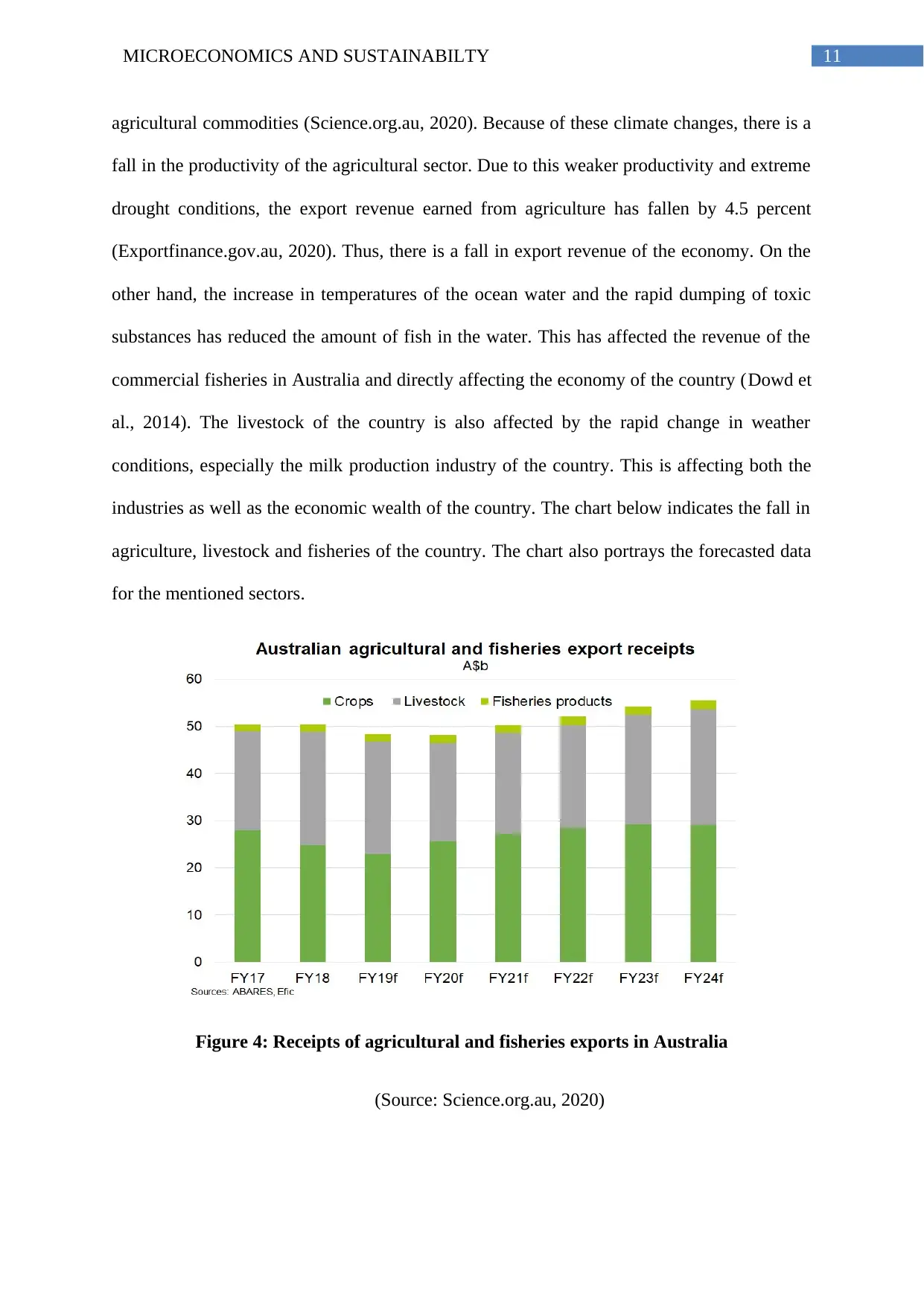
11MICROECONOMICS AND SUSTAINABILTY
agricultural commodities (Science.org.au, 2020). Because of these climate changes, there is a
fall in the productivity of the agricultural sector. Due to this weaker productivity and extreme
drought conditions, the export revenue earned from agriculture has fallen by 4.5 percent
(Exportfinance.gov.au, 2020). Thus, there is a fall in export revenue of the economy. On the
other hand, the increase in temperatures of the ocean water and the rapid dumping of toxic
substances has reduced the amount of fish in the water. This has affected the revenue of the
commercial fisheries in Australia and directly affecting the economy of the country (Dowd et
al., 2014). The livestock of the country is also affected by the rapid change in weather
conditions, especially the milk production industry of the country. This is affecting both the
industries as well as the economic wealth of the country. The chart below indicates the fall in
agriculture, livestock and fisheries of the country. The chart also portrays the forecasted data
for the mentioned sectors.
Figure 4: Receipts of agricultural and fisheries exports in Australia
(Source: Science.org.au, 2020)
agricultural commodities (Science.org.au, 2020). Because of these climate changes, there is a
fall in the productivity of the agricultural sector. Due to this weaker productivity and extreme
drought conditions, the export revenue earned from agriculture has fallen by 4.5 percent
(Exportfinance.gov.au, 2020). Thus, there is a fall in export revenue of the economy. On the
other hand, the increase in temperatures of the ocean water and the rapid dumping of toxic
substances has reduced the amount of fish in the water. This has affected the revenue of the
commercial fisheries in Australia and directly affecting the economy of the country (Dowd et
al., 2014). The livestock of the country is also affected by the rapid change in weather
conditions, especially the milk production industry of the country. This is affecting both the
industries as well as the economic wealth of the country. The chart below indicates the fall in
agriculture, livestock and fisheries of the country. The chart also portrays the forecasted data
for the mentioned sectors.
Figure 4: Receipts of agricultural and fisheries exports in Australia
(Source: Science.org.au, 2020)
⊘ This is a preview!⊘
Do you want full access?
Subscribe today to unlock all pages.

Trusted by 1+ million students worldwide
1 out of 17
Related Documents
Your All-in-One AI-Powered Toolkit for Academic Success.
+13062052269
info@desklib.com
Available 24*7 on WhatsApp / Email
![[object Object]](/_next/static/media/star-bottom.7253800d.svg)
Unlock your academic potential
Copyright © 2020–2025 A2Z Services. All Rights Reserved. Developed and managed by ZUCOL.




